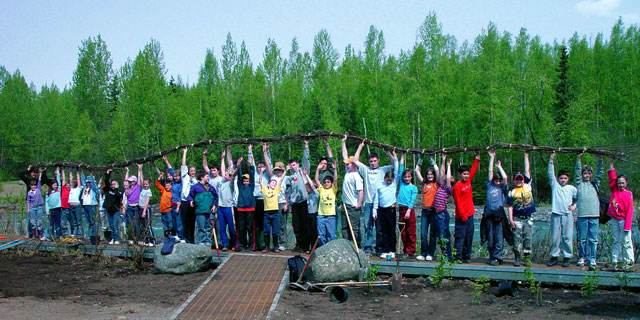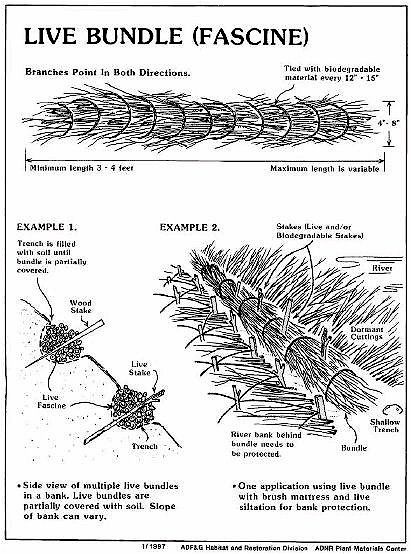Streambank Revegetation and Protection: A Guide for Alaska
Revegetation Techniques: Bundles (Fascines)

Bundles (fascines) are a group of dormant branches bound together to create a log-like structure that will root, grow and provide plant cover quickly. The bundle is used to revegetate and stabilize slopes, break-up slope length, and/or provide a transition from one revegetation technique to another (e.g., a brush mat to a live siltation). Bundles create small terraces that encourage native plant seed collection and growth.
Collection, storage and hand planting information are described under Dormant Cuttings in the Plant Care and Preparation section.
Tie together several dormant branches 1/2 to 2 inches in diameter and at least 3 to 4 feet long. Orient the cut ends of the branches in opposite directions to create a bundle with a uniform diameter. Typically, bundles are 4 or more inches in diameter and can be constructed to any length by overlapping branches as the bundle is formed and tying it tightly together with biodegradable twine, approximately every 1 to 2 feet.
Use a shovel or pick axe to dig a trench that slopes diagonally down and back into the hill. Install bundles by placing them horizontally in a shallow trench, burying approximately 3/4 the depth of the bundle diameter with soil, water and tamp in place to remove air pockets.
Drive at least two 18-inch wooden stakes or live willow stakes through the bundle to secure it firmly into the trench. If the slope is steep and the erosion potential is high, drive additional stakes downhill and immediately in front of the bundle. Do not cover the bundle entirely so it will be able to grow.
Place bundles end-to-end or slightly overlapping to form a continuous planting that should follow the contour of the slope. They can be planted in single or multiple rows or in a staggered pattern that reduces the surface erosion potential of a site. Fascines may also be placed in a "smile" configuration, with the fascine ends turned upslope. Location and spacing of the bundles will vary with site conditions and the overall revegetation design.
Advantages:
- In low velocity systems, this technique provides good density of vegetation and root matter
- Breaks up slope length
- Can be cost effective
- Easy to construct and install
- Provides terraced area for soil and seeds to settle
- Provides fish and wildlife habitat
Disadvantages:
- Requires a lot of willow
- May require additional toe-of-slope and bank stabilization using techniques listed in this guide

